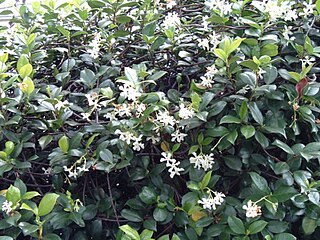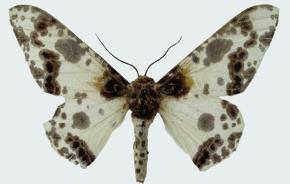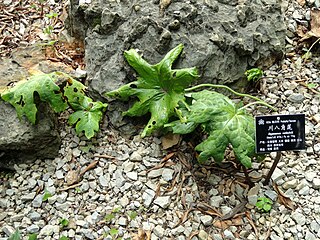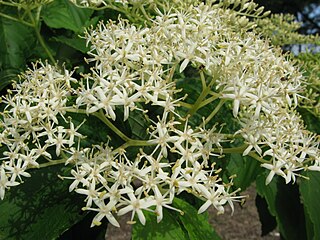
Arisaema is a large and diverse genus of the flowering plant family Araceae. The largest concentration of species is in China and Japan, with other species native to other parts of southern Asia as well as eastern and central Africa, Mexico and eastern North America. Asiatic species are often called cobra lilies, while western species are often called jack-in-the-pulpit; both names refer to the distinctive appearance of the flower, which consists of an erect central spadix rising from a spathe.

Adenophora is a genus of flowering plants in the family Campanulaceae, the bellflowers. Plants of this genus are known commonly as ladybells. Most are native to eastern Asia, with a few in Europe. Many are endemic to either China or Siberia.

Osmanthus is a genus of about 30 species of flowering plants in the family Oleaceae. Most of the species are native to eastern Asia with a few species from the Caucasus, New Caledonia and Sumatra.

Triadica is a plant genus of the family Euphorbiaceae first described as a genus in 1790. It is native to eastern southeastern, and southern Asia.
- Triadica cochinchinensisLour. - China, Cambodia, Assam, Bangladesh, Bhutan, Nepal, Himalayas of E + N India, Borneo, Sulawesi, Sumatra, Laos, Malaysia, Myanmar, Philippines, Thailand, Vietnam
- Triadica rotundifolia(Hemsl.) Esser - Guangdong
- Triadica sebifera(L.) Small - China, Japan; naturalized in Himalayas, Cuba, Puerto Rico, SE + SC USA, Sacramento Valley in N California

TrachelospermumStar Jasmine, Confederate Jasmine, is a genus of evergreen woody vines in the dogbane family Apocynaceae, first described as a genus in 1851. All species are native to southern and eastern Asia.

Rohdea is a genus of plants native to eastern Asia. It was long thought to contain only a single species, R. japonica, but recent studies have resulted in several other taxa being transferred into the genus.

The genus Helwingia consists of shrubs or rarely small trees native to eastern Asia, the Himalayas, and northern Indochina. It is the only genus in the family Helwingiaceae.

Linnaea is a plant genus in the family Caprifoliaceae. Until 2013, the genus included a single species, Linnaea borealis. In 2013, on the basis of molecular phylogenetic evidence, the genus was expanded to include species formerly placed in Abelia, Diabelia, Dipelta, Kolkwitzia and Vesalea. However, this is rejected by the majority of subsequent scientific literature and flora.

Hemipilia is a genus of plants in the family Orchidaceae. It is native to China, the Himalayas and Southeast Asia.

Neyraudia is a genus of Asian and African plants in the grass family.

Oreorchis is a genus of flowering plants from the orchid family, Orchidaceae. It is native to Asia. Species currently accepted as of June 2014:
- Oreorchis angustataL.O.Williams ex N.Pearce & P.J.Cribb - Sichuan, Yunnan
- Oreorchis aurantiacaP.J.Cribb & N.Pearce - Myanmar
- Oreorchis bilamellataFukuy. - Taiwan
- Oreorchis discigeraW.W.Sm. - Myanmar
- Oreorchis erythrochryseaHand.-Mazz. - Tibet, Sichuan, Yunnan
- Oreorchis fargesiiFinet - Fujian, Gansu, Hubei, Hunan, Shaanxi, Sichuan, Taiwan, Yunnan, Zhejiang
- Oreorchis foliosa(Lindl.) Lindl. - India, Assam, Nepal, Bhutan, Myanmar, Tibet, Sichuan, Taiwan, Yunnan
- Oreorchis itoana(F.Maek.) Perner - Honshu
- Oreorchis micranthaLindl. - Tibet, Taiwan, Assam, India, Bhutan, Nepal, Myanmar
- Oreorchis nanaSchltr. - Sichuan, Yunnan, Hubei
- Oreorchis nepalensisN.Pearce & P.J.Cribb - Nepal, Tibet
- Oreorchis oliganthaSchltr. - Gansu, Sichuan, Tibet, Yunnan
- Oreorchis parvulaSchltr. - Sichuan, Yunnan
- Oreorchis patens(Lindl.) Lindl. - Japan, Korea, Russian Far East, China
- Oreorchis porphyranthesTuyama - Nepal
- Oreorchis sanguinea(N.Pearce & P.J.Cribb) N.Pearce & P.J.Cribb - Bhutan

Biston panterinaria is a moth of the family Geometridae. It is found in China, India, Nepal, Sikkim, Vietnam and Thailand.

Dysosma is a group of herbaceous perennials in the Berberidaceae or barberry family described as a genus in 1928. It is native to China and Indochina.
Schnabelia is a genus of plants in the family Lamiaceae, first described in 1921. The entire genus is endemic to China.

Mosla is a genus of plants in the family Lamiaceae, first described as a genus in 1875. It is native to eastern Asia, the Himalayas, and southeastern Asia.
- Mosla bracteataDoan ex Suddee & A.J.Paton - Vietnam
- Mosla cavalerieiH.Lév.- Vietnam, Guangdong, Guangxi, Guizhou, Hubei, Jiangxi, Sichuan, Yunnan, Zhejiang
- Mosla chinensisMaxim. - Vietnam, Korea, Japan, Anhui, Fujian, Guangdong, Guangxi, Guizhou, Hubei, Hunan, Jiangsu, Jiangxi, Shandong, Sichuan, Taiwan, Zhejiang
- Mosla coreanaH.Lév. - Korea
- Mosla dianthera(Buch.-Ham. ex Roxb.) Maxim. - China, Japan, Korea, Ryukyu Islands, Kuril Islands, Primorye, Caucasus, Himalayas, Myanmar, Vietnam, Philippines, Sumatra
- Mosla exfoliata(C.Y.Wu) C.Y.Wu & H.W.Li - Sichuan
- Mosla hangchouensisMatsuda - Zhejiang
- Mosla japonica(Benth. ex Oliv.) Maxim. - Japan, Korea, Ryukyu Islands
- Mosla longibracteata(C.Y.Wu & S.J.Hsuan) C.Y.Wu & H.W.Li - Guangxi, Zhejiang
- Mosla longispica(C.Y.Wu) C.Y.Wu & H.W.Li - Jiangxi
- Mosla pauciflora(C.Y.Wu) C.Y.Wu & H.W.Li - Guizhou, Hubei, Sichuan
- Mosla punctulataNakai - Korea, Taiwan, Japan, China
- Mosla scabra(Thunb.) C.Y.Wu & H.W.Li - Vietnam, Korea, Japan, Ryukyu Islands, Anhui, Fujian, Gansu, Guangdong, Guangxi, Henan, Hubei, Hunan, Jiangsu, Jiangxi, Liaoning, Shaanxi, Sichuan, Taiwan, Zhejiang
- Mosla soochouensisMatsuda - Anhui, Jiangsu, Jiangxi, Zhejiang
- Mosla tamdaoensisPhuong - Vietnam

Microlepia is a genus of ferns in the family Dennstaedtiaceae described as a genus in 1836. Most of the species are native to Asia, with many endemic to China, although a few species occur also in Australia, Africa, the West Indies, Latin America, and various oceanic islands.

Glochidion puberum is a species of shrub or small tree in the family Phyllanthaceae. It is native to China, where it is widely distributed in both subtropical and temperate regions. It has also been reported from Taiwan and Japan, and is morphologically very similar to the species Glochidion chodoense, endemic to southern South Korea. In Mandarin it is known as 算盘子 (suanpanzi), which also refers to the genus Glochidion as a whole. In China it is used for medicinal purposes.

Cornus macrophylla, commonly known as the large-leafed dogwood, is a species of dogwood found in Afghanistan, Bhutan, India, Kashmir, Myanmar, Nepal, Pakistan, Taiwan, and several provinces in China, including Anhui, Fujian, Gansu, Guangdong, Guangxi, Guizhou, Hainan, Hubei, Hunan, Jiangsu, Jiangxi, Ningxia, Shaanxi, Shandong, Sichuan, Xizang, Yunnan, and Zhejiang.
Helwingia japonica, the Japanese helwingia, is a species of Helwingia native to East Asia. Helwingia japonica is part of the genus Helwingia and the family Helwingiaceae.
















